Did you know that in addition to trains, buses, and cabs, there is an unusual form of transportation in Osaka City? This time, I would like to introduce it to you. Tosen (ferry) . It is also called “watashi-bune”. As I mentioned in previous posts like, ” I will tell you how to get from USJ to Tempozan for free! “ , “[ Total length only 5km] Let’s explore the traditional area on a local train line in Osaka City. “ , in this article, I will show you some of the unknown charms of Osaka City by touring all eight ferry boats in the city at once. This is a one-day tour that takes you from the starting point to the end of the tour almost entirely on foot. Therefore, this article is intended for the following people. ・Those who would like to visit unknown tourist spots in Osaka City. ・Those who like to walk. If you meet these criteria, I am confident that you will enjoy this tour. So, I invite you to join me on a walking boat tour. I hope you enjoy the tour to the end.
Overview of ferry boats in Osaka City
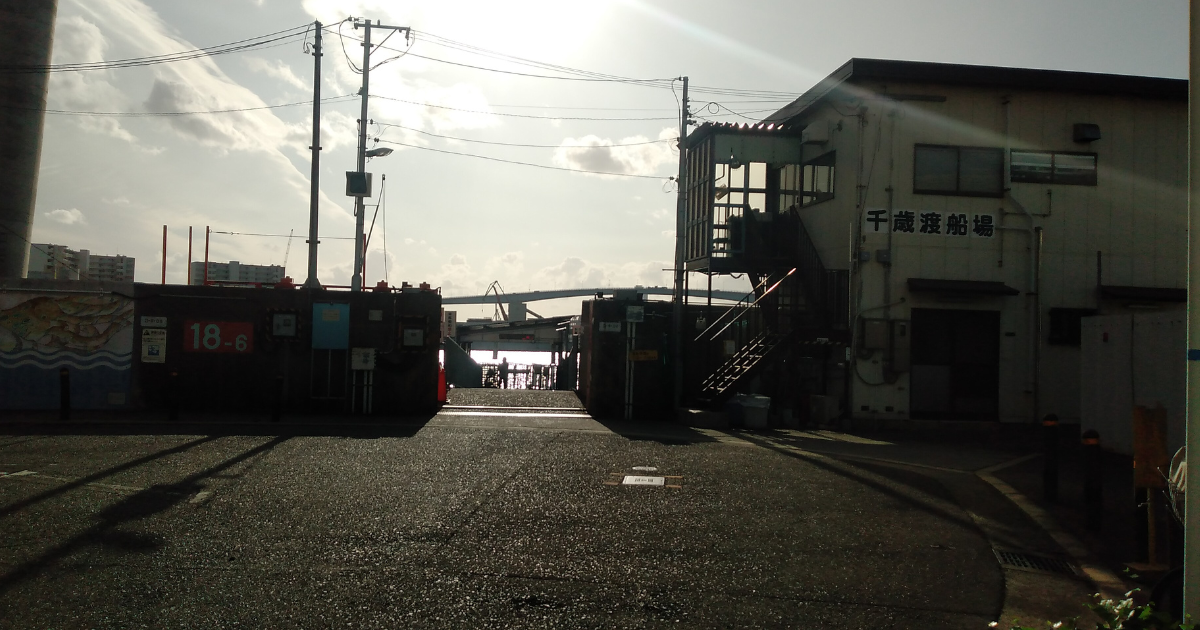 I explained the overview of the ferry service in the previously posted article ” I will tell you how to get from USJ to Tempozan for free! “. However, since some of you are reading this article for the first time, we will explain it once again. If you are already familiar with it, you may skip this section. Currently, there are a total of eight ferry ports in Osaka City. Seven of the eight locations are located in Taisho Ward, Osaka City, the hometown of Me Hiikun. The Taisho Ward side is the starting point* of the service, which runs to and from the surrounding Minato, Nishinari, Suminoe, and Taisho wards. Many local residents use the service for commuting to work and school, shopping, and leisure time. *The “starting point” here refers to the location where the crew stations are located. All are operated by the City of Osaka and are free of charge. Why is boarding free? The reason is that under the old Highway Law enacted in 1920, ferry boats are considered roads. In other words, ferry routes are treated the same as the roads that you travel every day. That is why they are free. There are two main reasons why ferry boats still exist today. One reason is that there are no bridges for people to cross where the ferry runs. Another reason is that the bridges are unusually large and high, making it difficult for people to cross them.
I explained the overview of the ferry service in the previously posted article ” I will tell you how to get from USJ to Tempozan for free! “. However, since some of you are reading this article for the first time, we will explain it once again. If you are already familiar with it, you may skip this section. Currently, there are a total of eight ferry ports in Osaka City. Seven of the eight locations are located in Taisho Ward, Osaka City, the hometown of Me Hiikun. The Taisho Ward side is the starting point* of the service, which runs to and from the surrounding Minato, Nishinari, Suminoe, and Taisho wards. Many local residents use the service for commuting to work and school, shopping, and leisure time. *The “starting point” here refers to the location where the crew stations are located. All are operated by the City of Osaka and are free of charge. Why is boarding free? The reason is that under the old Highway Law enacted in 1920, ferry boats are considered roads. In other words, ferry routes are treated the same as the roads that you travel every day. That is why they are free. There are two main reasons why ferry boats still exist today. One reason is that there are no bridges for people to cross where the ferry runs. Another reason is that the bridges are unusually large and high, making it difficult for people to cross them.
 This is the Namihaya Bridge. This is a large bridge connecting the southern part of Taisho Ward and Tempozan in Minato Ward. There are no ferries near this bridge, but there is a big and high bridge like this near some ferry ports. If you are interested in the Namihaya Bridge, please refer to this article I posted earlier. The bridge is built high near the mouth of the river to facilitate the passage of large boats. This makes it difficult just to climb up and down the bridges. Especially for the elderly, people with disabilities, and parents with small children, crossing these bridges can be a painstaking task. Taisho Ward is also said to be an area with poor transportation access. Railroads only run through a small portion of the northern part of the ward, and buses serve most of the ward. However, ferry boats help us when we want to go to places that are difficult to reach by train or bus. Moreover, bicyclists can also board the ferries. It is no exaggeration to say that it is an essential means of transportation for the local residents in Taisho and the surrounding wards. Hopefully, you understand to some extent what the ferry service in Taisho is. Now, let’s take a look at the itinerary of this ferry tour.
This is the Namihaya Bridge. This is a large bridge connecting the southern part of Taisho Ward and Tempozan in Minato Ward. There are no ferries near this bridge, but there is a big and high bridge like this near some ferry ports. If you are interested in the Namihaya Bridge, please refer to this article I posted earlier. The bridge is built high near the mouth of the river to facilitate the passage of large boats. This makes it difficult just to climb up and down the bridges. Especially for the elderly, people with disabilities, and parents with small children, crossing these bridges can be a painstaking task. Taisho Ward is also said to be an area with poor transportation access. Railroads only run through a small portion of the northern part of the ward, and buses serve most of the ward. However, ferry boats help us when we want to go to places that are difficult to reach by train or bus. Moreover, bicyclists can also board the ferries. It is no exaggeration to say that it is an essential means of transportation for the local residents in Taisho and the surrounding wards. Hopefully, you understand to some extent what the ferry service in Taisho is. Now, let’s take a look at the itinerary of this ferry tour. 
Itinerary of this ferry tour
This ferry tour will proceed according to the following itinerary. The starting point is the Taishobashi stop of the OsakaCity Bus, which is located near Taisho Station on the JR Osaka Loop Line and Osaka Metro Nagahori Tsurumi-ryokuchi Line. Take the No. 1 bus to the “Shin-Chitose” stop. From the “Shin-Chitose” stop, walk to each ferry terminal. After arriving at the other side of the river by the Tempozan ferry, walk to Sakurajima Station on the JR Yumesaki Line. Please note that from the “Shin-Chitose stop” of the OsakaCity bus to the “Sakurajima Station” of the JR Yumesaki Line, you can only take the ferry and walk, except for some sections. Now, let’s actually visit each ferry station. 
Chitose Ferry Port
Now, let’s go.  Go out the ticket gate of JR Taisho Station and turn left, and you will see Exit 2 of Osaka Metro Taisho Station. Immediately behind it, you will see ・・・・
Go out the ticket gate of JR Taisho Station and turn left, and you will see Exit 2 of Osaka Metro Taisho Station. Immediately behind it, you will see ・・・・  OsakaCity Bus “Taishobashi No.1 stop”.
OsakaCity Bus “Taishobashi No.1 stop”.  Take bus No. 87 or 98 to the “Shin-Chitose stop”.
Take bus No. 87 or 98 to the “Shin-Chitose stop”.  This is the “Shin-Chitose stop” of OsakaCity Bus. Please go straight toward the big bridge you can see in the back.
This is the “Shin-Chitose stop” of OsakaCity Bus. Please go straight toward the big bridge you can see in the back.

 This is Marin Tennis Park Kitamura. It is a well-known tennis facility in Osaka, where major tennis tournaments are often held. There is a tennis school attached to the park, and tennis lessons are also available. For more details, please click here.
This is Marin Tennis Park Kitamura. It is a well-known tennis facility in Osaka, where major tennis tournaments are often held. There is a tennis school attached to the park, and tennis lessons are also available. For more details, please click here. 
 Walking further, you will see a promenade on your left. Let’s take a short detour. If you go further, you will arrive at ・・・・
Walking further, you will see a promenade on your left. Let’s take a short detour. If you go further, you will arrive at ・・・・ 
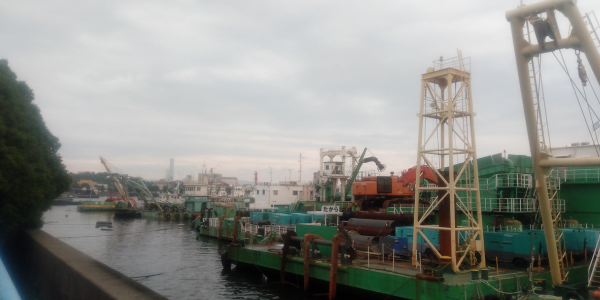
 where you can enjoy a panoramic view of the harbor. It is a great place to watch the sunset.
where you can enjoy a panoramic view of the harbor. It is a great place to watch the sunset.
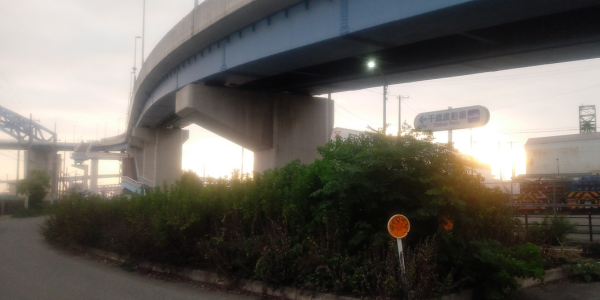 Now let’s go back. Please continue down the street under the bridge to the end of the street.
Now let’s go back. Please continue down the street under the bridge to the end of the street.
 A sign indicating the Chitose ferry port is now in sight. It may be difficult to understand, but it says 200 meters to go.
A sign indicating the Chitose ferry port is now in sight. It may be difficult to understand, but it says 200 meters to go.
 We have arrived at the Chitose ferry port. I took the photos from the beginning of this section to this point three days before the ferry excursion to save time. I took all photos from here on July 19, the day of the boat trip.
We have arrived at the Chitose ferry port. I took the photos from the beginning of this section to this point three days before the ferry excursion to save time. I took all photos from here on July 19, the day of the boat trip.
 Now, let’s get on the ferry.
Now, let’s get on the ferry.
 I boarded the boat which departed exactly at 14:00. There were 8 passengers including me.
I boarded the boat which departed exactly at 14:00. There were 8 passengers including me.
 You can also see the boarding area on the other side of the river.
You can also see the boarding area on the other side of the river.
 Now let’s set sail.
Now let’s set sail.

 Two large bridges can be seen in the background. The blue arrows point to the Namahaya Bridge, which I introduced earlier. For details, please refer to this article. The red arrow points to the Minato Ohashi Bridge. Please refer to our previous article on this bridge as well.
Two large bridges can be seen in the background. The blue arrows point to the Namahaya Bridge, which I introduced earlier. For details, please refer to this article. The red arrow points to the Minato Ohashi Bridge. Please refer to our previous article on this bridge as well.  Taisho Nai Harbor can be seen in the back. Many small and medium-sized boats are anchored there.
Taisho Nai Harbor can be seen in the back. Many small and medium-sized boats are anchored there.
 Directly above us is the Chitose Bridge. As you can see, it is a rather high and large bridge. Actually, it was rumored that after the Chitose-bashi Bridge was completed in 2003, the Chishima ferry was to be discontinued. However, this did not happen and the ferry is still in operation. Crossing this bridge is quite a hassle, and the ascent and descent alone are quite a big hassle. Instead, the view from the bridge is spectacular. During the daytime, the bridge runs every 20 minutes, so those who miss the boat and cannot wait, or those who want to get some exercise, use the bridge. The Chitose Bridge is still easy to cross. Later, we are going to see bridges much larger than the Chitose Bridge. You will understand more why the ferry service is necessary.
Directly above us is the Chitose Bridge. As you can see, it is a rather high and large bridge. Actually, it was rumored that after the Chitose-bashi Bridge was completed in 2003, the Chishima ferry was to be discontinued. However, this did not happen and the ferry is still in operation. Crossing this bridge is quite a hassle, and the ascent and descent alone are quite a big hassle. Instead, the view from the bridge is spectacular. During the daytime, the bridge runs every 20 minutes, so those who miss the boat and cannot wait, or those who want to get some exercise, use the bridge. The Chitose Bridge is still easy to cross. Later, we are going to see bridges much larger than the Chitose Bridge. You will understand more why the ferry service is necessary.  Even from here, you can see Abeno Harukas. You can see it from anywhere in Osaka.
Even from here, you can see Abeno Harukas. You can see it from anywhere in Osaka.
 The two-minute boat ride was over in a flash. The boat returned with passengers.
The two-minute boat ride was over in a flash. The boat returned with passengers.
 Now let’s go to the next ferry port.
Now let’s go to the next ferry port.
Funamachi Ferry Port
 The next location is the Funamachi ferry port. First, exit the Chitose ferry port (Tsurumachi side) and go straight until you reach the end of the street. Then turn left and go straight.
The next location is the Funamachi ferry port. First, exit the Chitose ferry port (Tsurumachi side) and go straight until you reach the end of the street. Then turn left and go straight.

 Go straight for a while and you will come to a large street. You will see a 7-Eleven on your left.
Go straight for a while and you will come to a large street. You will see a 7-Eleven on your left.
 If you continue to the right, you will reach the Namihaya Bridge.
If you continue to the right, you will reach the Namihaya Bridge.
 To get to the Funamachi ferry port, turn left.
To get to the Funamachi ferry port, turn left.
 A little further on, you will see a sign indicating the destination of the Funamachi ferry.
A little further on, you will see a sign indicating the destination of the Funamachi ferry.
 Go straight for a while…
Go straight for a while…
 Arrived.
Arrived.
 Unlike the Chitose ferry, it is very short. When we arrived, the boat was already on the other side of the river. Like the Chitose ferry, it runs every 20 minutes during the daytime. So we had to wait for 20 minutes for the next sailing.
Unlike the Chitose ferry, it is very short. When we arrived, the boat was already on the other side of the river. Like the Chitose ferry, it runs every 20 minutes during the daytime. So we had to wait for 20 minutes for the next sailing.
 There is a waiting room near the boarding area. I was a little tired from walking, so it was a good break.
There is a waiting room near the boarding area. I was a little tired from walking, so it was a good break.



 There was no air conditioning, but the breeze from the windows was pleasant. It cooled me off.
There was no air conditioning, but the breeze from the windows was pleasant. It cooled me off.
 The ship leaves exactly at 15:00. There were only two passengers including me.
The ship leaves exactly at 15:00. There were only two passengers including me.

 We reached the other side of the river in about 30 seconds. Despite the short distance, some of you may be thinking, “Do we really need a ferry in a place like this?”
We reached the other side of the river in about 30 seconds. Despite the short distance, some of you may be thinking, “Do we really need a ferry in a place like this?”  Yes, we need it! The reason is simple: there is no bridge nearby. The only bridge that allows people and vehicles to pass through is located about 800 meters away from here. You don’t have to go through that bridge, but you can avoid a detour by using this ferry.
Yes, we need it! The reason is simple: there is no bridge nearby. The only bridge that allows people and vehicles to pass through is located about 800 meters away from here. You don’t have to go through that bridge, but you can avoid a detour by using this ferry.
 After a 30-second boat ride, let’s go to our next destination.
After a 30-second boat ride, let’s go to our next destination.
Kizugawa ferry port
 The next stop is the Kizugawa ferry port. In fact, out of the eight ferry crossings, I have never used the Kizugawa ferry. This will be the first time for me to use it, so I am very much looking forward to it. After exiting the Funamachi ferry port, go straight until you reach the end of the street.
The next stop is the Kizugawa ferry port. In fact, out of the eight ferry crossings, I have never used the Kizugawa ferry. This will be the first time for me to use it, so I am very much looking forward to it. After exiting the Funamachi ferry port, go straight until you reach the end of the street.
 At the end of the street, turn left and continue straight. There are many steel mills, shipyards, and other factories in this area. There are not so many peopole even during the daytime. By the way, we are still in Taisho Ward.
At the end of the street, turn left and continue straight. There are many steel mills, shipyards, and other factories in this area. There are not so many peopole even during the daytime. By the way, we are still in Taisho Ward.
 After proceeding for a while, a large bridge comes into view. This bridge is the Shin-Kizugawa Bridge. It is a bridge with a total length of 2.4 km connecting Taisho Ward and Suminoe Ward on the other side of the river. It is up to 50 meters above the river surface. It was opened to traffic in 1994. The Taisho Ward side has a triple spiral shape. I have crossed this bridge several times, and I remember that it was very tiring. Just climbing up the triple spiral is a big challenge. Even during the daytime, there are some people crossing the Chitose Bridge. However, few people cross the Shin-Kizugawa Ohashi Bridge. Crossing this bridge is a big hassle. Therefore, you can understand how important the Kizugawa ferry is.
After proceeding for a while, a large bridge comes into view. This bridge is the Shin-Kizugawa Bridge. It is a bridge with a total length of 2.4 km connecting Taisho Ward and Suminoe Ward on the other side of the river. It is up to 50 meters above the river surface. It was opened to traffic in 1994. The Taisho Ward side has a triple spiral shape. I have crossed this bridge several times, and I remember that it was very tiring. Just climbing up the triple spiral is a big challenge. Even during the daytime, there are some people crossing the Chitose Bridge. However, few people cross the Shin-Kizugawa Ohashi Bridge. Crossing this bridge is a big hassle. Therefore, you can understand how important the Kizugawa ferry is.
 A short walk along the Shin-Kizugawa Ohashi Bridge will bring you to the Kizugawa ferry port.
A short walk along the Shin-Kizugawa Ohashi Bridge will bring you to the Kizugawa ferry port.

 During the daytime, the ferry runs every 45 minutes. Of all the eight ferry crossings in Osaka, this is the least frequent during the daytime.
During the daytime, the ferry runs every 45 minutes. Of all the eight ferry crossings in Osaka, this is the least frequent during the daytime.
 The next sailing is at 15:45. I arrived 30 minutes before that.
The next sailing is at 15:45. I arrived 30 minutes before that.
 I didn’t play with my phone, didn’t think about anything, just spent time looking at the scenery in front of me.
I didn’t play with my phone, didn’t think about anything, just spent time looking at the scenery in front of me.
 After 30 minutes, the boat is ready to sail. There are three passengers including me.
After 30 minutes, the boat is ready to sail. There are three passengers including me.


 I saw the Shin Kizugawa Bridge from a boat and was overwhelmed by its sheer size.
I saw the Shin Kizugawa Bridge from a boat and was overwhelmed by its sheer size.
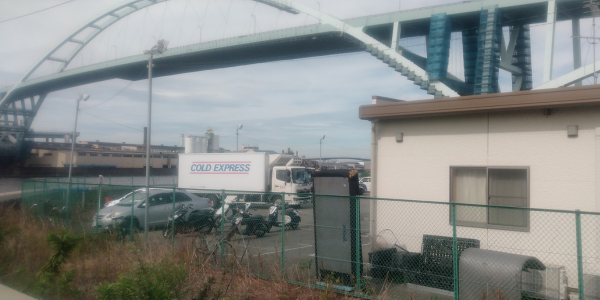 It took about 2 minutes to reach the other bank. If we used the Shin-Kizugawa Ohashi Bridge, it would take at least 10 minutes to reach the other side of the river on foot. Once again, I recognized the importance of the ferry. Now, let’s proceed further.
It took about 2 minutes to reach the other bank. If we used the Shin-Kizugawa Ohashi Bridge, it would take at least 10 minutes to reach the other side of the river on foot. Once again, I recognized the importance of the ferry. Now, let’s proceed further.
Senbonmatsu Ferry Port
 After exiting the Kizugawa ferry port, proceed to the bridge you see ahead.
After exiting the Kizugawa ferry port, proceed to the bridge you see ahead.

 You will see a pedestrian bridge on your left. Cross this bridge and go straight.
You will see a pedestrian bridge on your left. Cross this bridge and go straight.
 The Shin-Kizugawa Bridge can be seen from here as well. This view shows how long this bridge is.
The Shin-Kizugawa Bridge can be seen from here as well. This view shows how long this bridge is.
 Get off the pedestrian bridge and go straight for a while. A yellow arrow points to the entrance and exit of the Shin-Kizugawa Ohashi Bridge (Suminoe Ward side). The Taisho Ward side has a triple spiral, while the Suminoe Ward side has a slope shaped like the letter “し” in hiragana.
Get off the pedestrian bridge and go straight for a while. A yellow arrow points to the entrance and exit of the Shin-Kizugawa Ohashi Bridge (Suminoe Ward side). The Taisho Ward side has a triple spiral, while the Suminoe Ward side has a slope shaped like the letter “し” in hiragana.
 After a short distance, you will see a “SUBARU” sign ahead. Turn left at this intersection.
After a short distance, you will see a “SUBARU” sign ahead. Turn left at this intersection.
 Turn left and go straight to the end of the street.
Turn left and go straight to the end of the street.
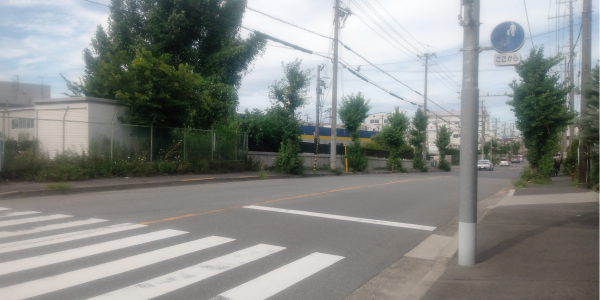 At the end of the street, turn right and go straight. After walking for a while, you will see an old sign…
At the end of the street, turn right and go straight. After walking for a while, you will see an old sign… 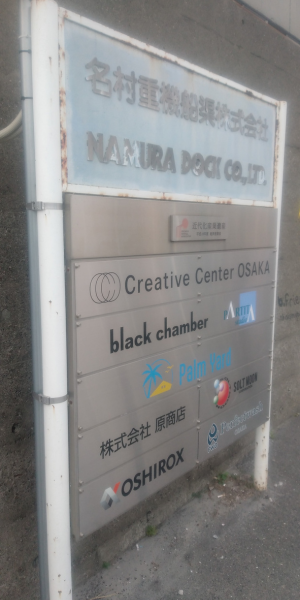 It reads, “Namura Heavy Machinery Dock Co. There are several other names of companies and organizations on the sign.
It reads, “Namura Heavy Machinery Dock Co. There are several other names of companies and organizations on the sign.  There is a sign near the entrance. What is this place?
There is a sign near the entrance. What is this place?  This is the former site of the Osaka factory of Namura Shipbuilding Co. The shipyard was founded by Mr. Gennosuke Namura in 1911. The head office is still located in Nishi Ward, Osaka City. However, the shipyard was relocated to Imari City, Saga Prefecture in the 1970s. As a result, the Osaka factory was closed. Despite the fact that many years have passed since its closure, some of the shipyard buildings and the shipyard dock still remain as they were in those days. Making effective use of them, various events related to art and music are held there. Please refer to this page for details. On this day, there was also an event going on, but I had to give up due to time constraints. If I have a chance, I would like to visit this place
This is the former site of the Osaka factory of Namura Shipbuilding Co. The shipyard was founded by Mr. Gennosuke Namura in 1911. The head office is still located in Nishi Ward, Osaka City. However, the shipyard was relocated to Imari City, Saga Prefecture in the 1970s. As a result, the Osaka factory was closed. Despite the fact that many years have passed since its closure, some of the shipyard buildings and the shipyard dock still remain as they were in those days. Making effective use of them, various events related to art and music are held there. Please refer to this page for details. On this day, there was also an event going on, but I had to give up due to time constraints. If I have a chance, I would like to visit this place
 The wall covering the former site of the Namura Shipyard Osaka factory is decorated with cute illustrations like this one. Continue straight down this street.
The wall covering the former site of the Namura Shipyard Osaka factory is decorated with cute illustrations like this one. Continue straight down this street.
 You will see a green building ahead. Turn left at this intersection.
You will see a green building ahead. Turn left at this intersection.
 Going straight ahead, you will see some kind of spiral bridge.
Going straight ahead, you will see some kind of spiral bridge.
 This is the Senbonmatsu Bridge. Both entrances and exits are double spirals. It is called “Megane-bashi” (glasses bridge) by the locals because it looks like a pair of glasses when seen from above. The bridge is surprisingly old, having been completed in 1973. Like the Shin-Kizugawa Bridge, it is quite difficult to cross.
This is the Senbonmatsu Bridge. Both entrances and exits are double spirals. It is called “Megane-bashi” (glasses bridge) by the locals because it looks like a pair of glasses when seen from above. The bridge is surprisingly old, having been completed in 1973. Like the Shin-Kizugawa Bridge, it is quite difficult to cross.

 It was already around 4:30 p.m., but the sun was still shining and it was very hot and humid. I was not in the mood to cross the bridge. Therefore, I decided to use the ferry. The 16:30 boat had just left, so I waited for the next boat at 16:45.
It was already around 4:30 p.m., but the sun was still shining and it was very hot and humid. I was not in the mood to cross the bridge. Therefore, I decided to use the ferry. The 16:30 boat had just left, so I waited for the next boat at 16:45.
 You can see the Shin-Kizugawa Bridge over there. It took me about 40 minutes to walk from there. Let’s take a break until the boat comes.
You can see the Shin-Kizugawa Bridge over there. It took me about 40 minutes to walk from there. Let’s take a break until the boat comes.

 The Senbonmatsu Bridge is approximately 1.2 km long and 33 m high. In addition to walking and bicycling, it is also possible to cross the bridge by bus. Osaka City Bus No. 76, Dome-mae Chiyozaki to Subway Suminoe Koen, crosses this bridge. If you would like to see the timetable of the buses departing from Taishobashi (in front of Taisho Station) to Subway Suminoe Koen, please refer to this page.
The Senbonmatsu Bridge is approximately 1.2 km long and 33 m high. In addition to walking and bicycling, it is also possible to cross the bridge by bus. Osaka City Bus No. 76, Dome-mae Chiyozaki to Subway Suminoe Koen, crosses this bridge. If you would like to see the timetable of the buses departing from Taishobashi (in front of Taisho Station) to Subway Suminoe Koen, please refer to this page. 
 The wind is pleasant. You can see the skyscrapers of Umeda from here. I wonder how many people in the Umeda area know about this ferry.
The wind is pleasant. You can see the skyscrapers of Umeda from here. I wonder how many people in the Umeda area know about this ferry.
 While I was thinking about this, the boat arrived at the other side of the river. I was back in Taisho Ward. I forgot to mention that the other side of the river is Nishinari Ward.
While I was thinking about this, the boat arrived at the other side of the river. I was back in Taisho Ward. I forgot to mention that the other side of the river is Nishinari Ward.
 You will see a large plaza on your left.
You will see a large plaza on your left.
 Local elementary school students were practicing baseball. The open space is well utilized.
Local elementary school students were practicing baseball. The open space is well utilized.
 I have now completed half of the ride. Let’s move on.
I have now completed half of the ride. Let’s move on.
Ochiaishimo Ferry Port
 The next stop is the Ochiaishimo ferry port. It is located about 15 minutes from here.
The next stop is the Ochiaishimo ferry port. It is located about 15 minutes from here.
 This area is called Hirao. I, hiikun, was born and raised in this area. Hirao Elementary School, my alma mater, is located a little further down the street. I used to play with my friends at Hirao Park located in front of the school. Whenever I pass by this area, my childhood memories come back to me.
This area is called Hirao. I, hiikun, was born and raised in this area. Hirao Elementary School, my alma mater, is located a little further down the street. I used to play with my friends at Hirao Park located in front of the school. Whenever I pass by this area, my childhood memories come back to me.
 As I continued walking, feeling nostalgic… I saw a sign for the Ochiaishimo ferry port.
As I continued walking, feeling nostalgic… I saw a sign for the Ochiaishimo ferry port.

 Then let’s ride.
Then let’s ride.
 I must apologize for the inconvenience. I suddenly had to post a picture of the other side of the river. I had given up hope of getting on the ship departing at exactly 5:00 p.m., but I was able to get on the ship just before it left. However, I boarded the ferry just before it departed. It was very crowded and I could not take pictures because I boarded the ship just before the departure.
I must apologize for the inconvenience. I suddenly had to post a picture of the other side of the river. I had given up hope of getting on the ship departing at exactly 5:00 p.m., but I was able to get on the ship just before it left. However, I boarded the ferry just before it departed. It was very crowded and I could not take pictures because I boarded the ship just before the departure.
 The Senbonmatsu Bridge can be seen in the back. In fact, from Ochiaishimo ferry, you can see the Senbonmatsu ferry and the Ochiaikami ferry that you will board later. It depends on the timetable.
The Senbonmatsu Bridge can be seen in the back. In fact, from Ochiaishimo ferry, you can see the Senbonmatsu ferry and the Ochiaikami ferry that you will board later. It depends on the timetable.
 Unfortunately, I could not photograph too many of them. I can’t stay depressed, so let’s just move on.
Unfortunately, I could not photograph too many of them. I can’t stay depressed, so let’s just move on.
Ochiaikami Ferry Port
 Turn left after exiting the ferry terminal. *By the way, this is Nishinari Ward.
Turn left after exiting the ferry terminal. *By the way, this is Nishinari Ward.
 Continue further north.
Continue further north.

 It is about a 10-minute walk. The signboard that reads “Kizugawa BASE” is a landmark.
It is about a 10-minute walk. The signboard that reads “Kizugawa BASE” is a landmark.
 You will see a sign that reads “Ochiai Kaminowatari.” If you continue down this narrow alley…
You will see a sign that reads “Ochiai Kaminowatari.” If you continue down this narrow alley… 
 you will arrive at the Ochiaikami ferry port. The huge arched structure in the back is the Kizu River sluice gate. Actually, you can read more about the Ochiaigami ferry terminal and the Kizu River sluice gate in my previous post. Please refer to this page if you like.
you will arrive at the Ochiaikami ferry port. The huge arched structure in the back is the Kizu River sluice gate. Actually, you can read more about the Ochiaigami ferry terminal and the Kizu River sluice gate in my previous post. Please refer to this page if you like.  Ochiaigami ferry port is located in a residential area, not a factory area, giving it a quiet and calm atmosphere.
Ochiaigami ferry port is located in a residential area, not a factory area, giving it a quiet and calm atmosphere.  Now, the 5:30 p.m. boat has arrived.
Now, the 5:30 p.m. boat has arrived.  Now, let’s set sail.
Now, let’s set sail. 
 The view of Kizugawa Suimon from the boat is fantastic. As mentioned in my previous post, the Kizu River sluice gate will disappear in a few years. More than 50 years have already passed since its completion. It has protected us from various floods. In order to protect us from typhoons, floods, and giant tsunamis, and for seismic reinforcement, a new sluice gate will be constructed a little upstream from where the Kizu River sluice gate is currently located. You can see a crane truck behind the sluice gate, and it seems that construction of the new sluice gate has already started. The current Kizu River sluice gate will not be visible for several years, so please come and see it while you can.
The view of Kizugawa Suimon from the boat is fantastic. As mentioned in my previous post, the Kizu River sluice gate will disappear in a few years. More than 50 years have already passed since its completion. It has protected us from various floods. In order to protect us from typhoons, floods, and giant tsunamis, and for seismic reinforcement, a new sluice gate will be constructed a little upstream from where the Kizu River sluice gate is currently located. You can see a crane truck behind the sluice gate, and it seems that construction of the new sluice gate has already started. The current Kizu River sluice gate will not be visible for several years, so please come and see it while you can.



 I have now visited 6 out of 8 locations. Have you noticed anything so far? Yes, four of the eight ferry crossings are on the same river, the Kizu River. There are few bridges downstream of the Kizu River that we can cross by foot or bicycle. And even if there are bridges, they are too high and take time to cross. We proceeded on our way, reaffirming the importance of crossing the river by boat. There are only two more places to go. Let’s go!
I have now visited 6 out of 8 locations. Have you noticed anything so far? Yes, four of the eight ferry crossings are on the same river, the Kizu River. There are few bridges downstream of the Kizu River that we can cross by foot or bicycle. And even if there are bridges, they are too high and take time to cross. We proceeded on our way, reaffirming the importance of crossing the river by boat. There are only two more places to go. Let’s go!
Jinbei Ferry Port

 Let’s head to the Jimpei ferry port, which has two more locations to go. After exiting the Ochiaikami ferry port, go left and you will see a traffic light. Turn right there.
Let’s head to the Jimpei ferry port, which has two more locations to go. After exiting the Ochiaikami ferry port, go left and you will see a traffic light. Turn right there.
 Go straight down this street for a while. Then you will see a shopping mall on your right…
Go straight down this street for a while. Then you will see a shopping mall on your right…  called Chishima Garden Mall. And this store is “Farmer’s Fruit”. It sells sweets and drinks made from domestic fruits. And across the street is …
called Chishima Garden Mall. And this store is “Farmer’s Fruit”. It sells sweets and drinks made from domestic fruits. And across the street is …  Ronparu, a bakery famous for its honey doughnuts. I thought about buying something here, eating and taking a break. However, due to time constraints, I had to give up. For more information about these two stores, please refer to this page.
Ronparu, a bakery famous for its honey doughnuts. I thought about buying something here, eating and taking a break. However, due to time constraints, I had to give up. For more information about these two stores, please refer to this page.  A little further on…
A little further on… 
 You will see a path leading to the site of the apartment complex. Please continue on this path. When you get to the top of the hill, turn right.
You will see a path leading to the site of the apartment complex. Please continue on this path. When you get to the top of the hill, turn right.
 Go straight for a while.
Go straight for a while.
 You will come to a large plaza. The brown building in the back in the middle is Taisho Ward Office. Please walk toward there.
You will come to a large plaza. The brown building in the back in the middle is Taisho Ward Office. Please walk toward there.
 Behind this is the symbol of Taisho Ward, Mt. Showa. I did not stop by as it was not included in this project. Please refer to this article for details.
Behind this is the symbol of Taisho Ward, Mt. Showa. I did not stop by as it was not included in this project. Please refer to this article for details.  Going down this hill…
Going down this hill… 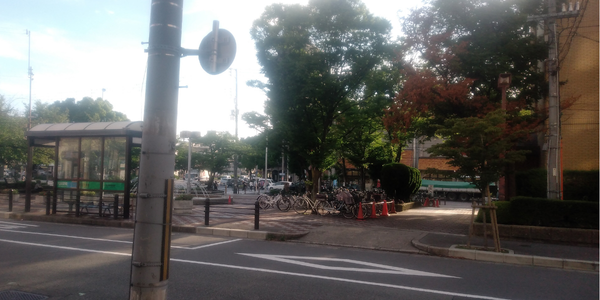 you will reach another square.
you will reach another square.  This is Taisho-dori, the main street of Taisho Ward.
This is Taisho-dori, the main street of Taisho Ward.  If you go this way, you will reach Taisho Station.
If you go this way, you will reach Taisho Station.  Cross the traffic light and go straight. Just as I was about to walk further, I ran into a problem. The battery of my cell phone was about to run out. I had no choice but to return home to recharge it. However, I was rather glad that my cell phone battery was about to run out. I was able to take a break while charging.
Cross the traffic light and go straight. Just as I was about to walk further, I ran into a problem. The battery of my cell phone was about to run out. I had no choice but to return home to recharge it. However, I was rather glad that my cell phone battery was about to run out. I was able to take a break while charging.
 I took a break for about 50 minutes and resumed the ferry tour. Continue straight down this street.
I took a break for about 50 minutes and resumed the ferry tour. Continue straight down this street.

 Hmm? I arrived at a place that looks familiar. Yes, it is the intersection near the Shin-Chitose stop. You can see the Chitose Bridge in the back.
Hmm? I arrived at a place that looks familiar. Yes, it is the intersection near the Shin-Chitose stop. You can see the Chitose Bridge in the back.
 However, we go in the opposite direction.
However, we go in the opposite direction.
 After a short distance, you will see a “Sandy” supermarket. Turn left at the corner.
After a short distance, you will see a “Sandy” supermarket. Turn left at the corner. 
 Continue to the end of the street and turn right.
Continue to the end of the street and turn right.  After about 50 meters, you will see…
After about 50 meters, you will see…  You have arrived at Jinpei Ferry Terminal. This is the busiest and most frequently operated of the eight ferry crossings in Osaka.
You have arrived at Jinpei Ferry Terminal. This is the busiest and most frequently operated of the eight ferry crossings in Osaka.


 When I arrived, the boat had already left. I waited for the next boat at 19:15.
When I arrived, the boat had already left. I waited for the next boat at 19:15.

 The ship is about to depart. There were about 10 passengers including me.
The ship is about to depart. There were about 10 passengers including me.
 This river is called the Shirinashi River. Like the Kizu River, an arched sluice gate can be seen. It will be rebuilt and disappear in a few years, so now is the time to see it.
This river is called the Shirinashi River. Like the Kizu River, an arched sluice gate can be seen. It will be rebuilt and disappear in a few years, so now is the time to see it.

 Escaped Taisho Ward again. I am now in Minato Ward. There is only one ferry remaining.
Escaped Taisho Ward again. I am now in Minato Ward. There is only one ferry remaining.
Tempozan Ferry Port
The last stop is the Tempozan ferry terminal. In my previous post ” I’ll tell you how to get from USJ to Tempozan for free! “ , if you have read my previous post, you probably know this. This is the only ferry located outside of Taisho Ward out of a total of 8 ferry locations. It connects Chikko in Minato Ward with Sakurajima in Konohana Ward. It is probably the most well-known ferry among tourists because it connects two major tourist attractions, Tempozan and USJ. Let’s take a look.
 When you exit the Jinbei ferry port, you will see a straight road in front of you. Anyway, please go straight on that road.
When you exit the Jinbei ferry port, you will see a straight road in front of you. Anyway, please go straight on that road.  If you go straight…
If you go straight…  you will reach a big street. It is called Minato Dori. If you go west on Minato Dori, you can go to Tempozan. But I, hiikun, had no strength left to walk. So…
you will reach a big street. It is called Minato Dori. If you go west on Minato Dori, you can go to Tempozan. But I, hiikun, had no strength left to walk. So…  There is Osaka City Bus Yunagi stop, a little east of Minato Dori. I decided to take a bus from there to Tempozan.
There is Osaka City Bus Yunagi stop, a little east of Minato Dori. I decided to take a bus from there to Tempozan.
 Quite a number of trains are available. I was lucky enough to get on without waiting.
Quite a number of trains are available. I was lucky enough to get on without waiting.
 About 15 minutes after the Yunagi stop, I arrived at the Tempozan Harbor Village stop. When I got off the bus, the Giant Ferris Wheel appeared in front of me…
About 15 minutes after the Yunagi stop, I arrived at the Tempozan Harbor Village stop. When I got off the bus, the Giant Ferris Wheel appeared in front of me… 
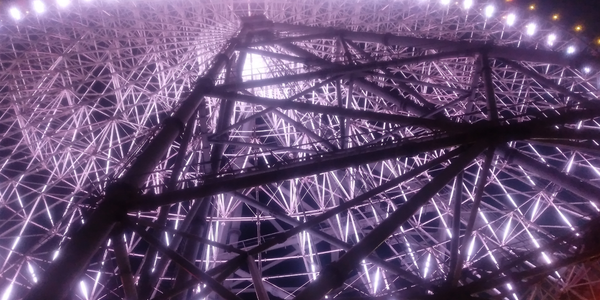
 It is one of the famous landmarks of Tempozan. The moment I saw it, my fatigue was gone. Even though it was before 8 p.m., there were surprisingly many people around. There was a long queue for the Ferris wheel.
It is one of the famous landmarks of Tempozan. The moment I saw it, my fatigue was gone. Even though it was before 8 p.m., there were surprisingly many people around. There was a long queue for the Ferris wheel.


 This is the renovated Tempozan Passenger Boat Terminal. It will be used as a departure and arrival area for large passenger ships. When the terminal is not used by large passenger ships, it will be rented out as a venue for events. (Quoted from this article. Let’s go further.
This is the renovated Tempozan Passenger Boat Terminal. It will be used as a departure and arrival area for large passenger ships. When the terminal is not used by large passenger ships, it will be rented out as a venue for events. (Quoted from this article. Let’s go further. 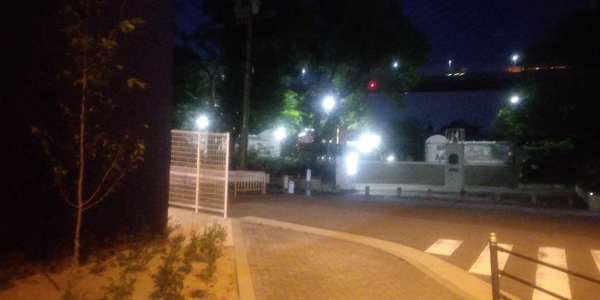 Looking behind me…
Looking behind me… 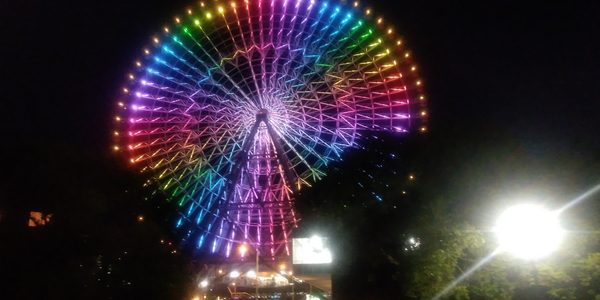 I saw a Ferris wheel glowing in rainbow colors. Lovely!
I saw a Ferris wheel glowing in rainbow colors. Lovely! 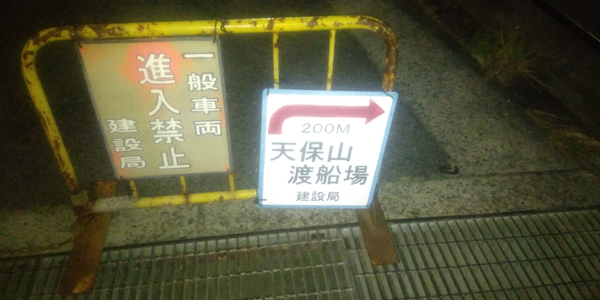
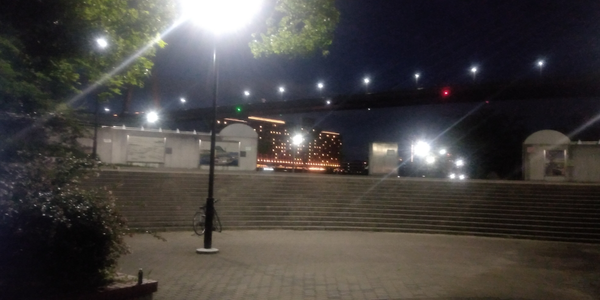 Passing through Tempozan Park…
Passing through Tempozan Park…  you can see the Aji River. As we proceeded along the promenade…
you can see the Aji River. As we proceeded along the promenade…  This is the 8th and last stop, Tempozan Ferry Port. A boat was about to depart at exactly 20:00. I did not take this boat.
This is the 8th and last stop, Tempozan Ferry Port. A boat was about to depart at exactly 20:00. I did not take this boat.


 I, hiikun, will be on the last ferry of the day, departing at 20:30. The passengeras of the Tenpozan ferry are very different from the other seven. The other seven ferry lines are used almost exclusively by locals. On the other hand, the Tempozan ferry is used not only by locals but also by many tourists. The use by foreign tourists is especially noticeable. In addition, many foreign employees of USJ also use the boat. Therefore, it is very interesting to hear various languages being spoken on the ship. As mentioned at the beginning of this article, this ferry port is located near major tourist attractions such as Tempozan and USJ. Therefore, if I were to recommend one of the eight ferry crossings to visitors, I would recommend the Tempozan ferry without hesitation.
I, hiikun, will be on the last ferry of the day, departing at 20:30. The passengeras of the Tenpozan ferry are very different from the other seven. The other seven ferry lines are used almost exclusively by locals. On the other hand, the Tempozan ferry is used not only by locals but also by many tourists. The use by foreign tourists is especially noticeable. In addition, many foreign employees of USJ also use the boat. Therefore, it is very interesting to hear various languages being spoken on the ship. As mentioned at the beginning of this article, this ferry port is located near major tourist attractions such as Tempozan and USJ. Therefore, if I were to recommend one of the eight ferry crossings to visitors, I would recommend the Tempozan ferry without hesitation.
 The ship will be leaving soon.
The ship will be leaving soon.

 I apologize for the blurriness of the image. I was trying to take a picture after setting sail, but there was a slight malfunction and this is the result. Of course, the night view of the skyscrapers of Umeda was clearly visible to the naked eye.
I apologize for the blurriness of the image. I was trying to take a picture after setting sail, but there was a slight malfunction and this is the result. Of course, the night view of the skyscrapers of Umeda was clearly visible to the naked eye.
 By the way, this is what it looks like during the day. This is a picture I took when I took the captain’s line in the past. You can see the scenery like this even if you take the Tenpozan ferry during the daytime. Please refer to this article for more information on the Captain Line.
By the way, this is what it looks like during the day. This is a picture I took when I took the captain’s line in the past. You can see the scenery like this even if you take the Tenpozan ferry during the daytime. Please refer to this article for more information on the Captain Line.  The long trip of eight ferry crossings was coming to an end.
The long trip of eight ferry crossings was coming to an end.  After picking up the passengers waiting on the other side of the river, the boat returned quickly. This is the end of today’s operation of the Tenpozan ferry.
After picking up the passengers waiting on the other side of the river, the boat returned quickly. This is the end of today’s operation of the Tenpozan ferry.
 Unlike the Tempozan side, the Sakurajima side is very quiet.
Unlike the Tempozan side, the Sakurajima side is very quiet.
 The JR Yumesaki Line Sakurajima Station, the last stop, is just a short distance away.
The JR Yumesaki Line Sakurajima Station, the last stop, is just a short distance away.
 Go straight to the first traffic light. Turn right at the corner.
Go straight to the first traffic light. Turn right at the corner.  Go straight…
Go straight…  You will reach a big street. If you go straight here anyway…
You will reach a big street. If you go straight here anyway…  You have arrived at Sakurajima Station on the JR Yumesaki Line. This is the end of all the itinerary. I left home a little after 1:30 p.m. and arrived at Sakurajima Station at around 8:50 p.m. The seven-hour ferry trip was physically demanding. However, I rediscovered the charm of the ferry and discovered something new outside of the ferry. It had been a long time since I had walked so much. Thanks to that, I was able to sleep well. (Completed)
You have arrived at Sakurajima Station on the JR Yumesaki Line. This is the end of all the itinerary. I left home a little after 1:30 p.m. and arrived at Sakurajima Station at around 8:50 p.m. The seven-hour ferry trip was physically demanding. However, I rediscovered the charm of the ferry and discovered something new outside of the ferry. It had been a long time since I had walked so much. Thanks to that, I was able to sleep well. (Completed)
What to prepare for a walking tour of the ferry
Here are some things you should do to prepare for your ferry tour on foot. Get a good night’s sleep the night before. And please eat a good breakfast. You will be walking a considerable distance. Wear clothes that are easy to move in. Especially shoes.  No sandals or high heels.
No sandals or high heels.
 Shoes that can withstand long walking are preferable. Moreover, it would be better if the shoes are comfortable for you. By the way, I, hiikun, am a fan of ASICS WALKING. Since I came across this brand, I have been able to find the perfect shoes for my feet. Thanks to them, I can now enjoy walking. I have been using the shoes in the photo for more than 6 years since I bought them. However, there is no noticeable damage and I am still using them today.
Shoes that can withstand long walking are preferable. Moreover, it would be better if the shoes are comfortable for you. By the way, I, hiikun, am a fan of ASICS WALKING. Since I came across this brand, I have been able to find the perfect shoes for my feet. Thanks to them, I can now enjoy walking. I have been using the shoes in the photo for more than 6 years since I bought them. However, there is no noticeable damage and I am still using them today.
 Remember to wear a hat, sunglasses, parasol, sunscreen, etc. to protect yourself from UV rays and heat stroke. It is also important to drink water frequently and take appropriate breaks. If you feel you can’t do it, stop immediately. There is no need to visit the entire tour in a single day. The most important thing is to enjoy the tour. Plan your tour within a reasonable range. (M)《アシックス公式》 スニーカー 【ハダシウォーカー メンズ GORE-TEX防水】 ASICS WALKING WELLNESS WALKER アシックスウォーキング シューズ・靴 スニーカー【送料無料】[Rakuten Fashion]
Remember to wear a hat, sunglasses, parasol, sunscreen, etc. to protect yourself from UV rays and heat stroke. It is also important to drink water frequently and take appropriate breaks. If you feel you can’t do it, stop immediately. There is no need to visit the entire tour in a single day. The most important thing is to enjoy the tour. Plan your tour within a reasonable range. (M)《アシックス公式》 スニーカー 【ハダシウォーカー メンズ GORE-TEX防水】 ASICS WALKING WELLNESS WALKER アシックスウォーキング シューズ・靴 スニーカー【送料無料】[Rakuten Fashion]
summary
How was this trip? Let’s take a look back at the itinerary. 14:00, Chitose ferry ↓ 15:00, Funamachi ferry ↓ 15:45, Kizugawa ferry ↓ 16:45, Senbonmatsu ferry ↓ 17:00, Ochiaishimo ferry ↓ 17:30, Ochiaikami ferry ↓ 19:15, Jinpei ferry ↓ 20:30, Tempozan ferry It took about 7 hours to reach Sakurajima Station of JR Yumesaki Line. I took frequent breaks along the way. I think the journey was quite strenuous. However, I was able to spend a fulfilling day with new discoveries. This itinerary is just one example. You don’t necessarily have to copy it. You can also divide your visit into multiple days. You don’t have to visit everything, just the places that interest you. If walking is not your thing, you can also tour the area by bicycle. On YouTube, people who have visited all of Osaka’s ferry ports by bicycle have recorded and posted videos of their visits. You may want to refer to those videos. In other words, it is up to you, my readers, to decide how to enjoy it. I hope you will enjoy your ferry cruise. I hope that this article will help my readers in your ferry tours. Do not forget to take precautions against ultraviolet rays and heat stroke, especially when doing so in mid-summer! Enjoy your trip as much as you can. Well, I look forward to seeing you again in the next article. 



